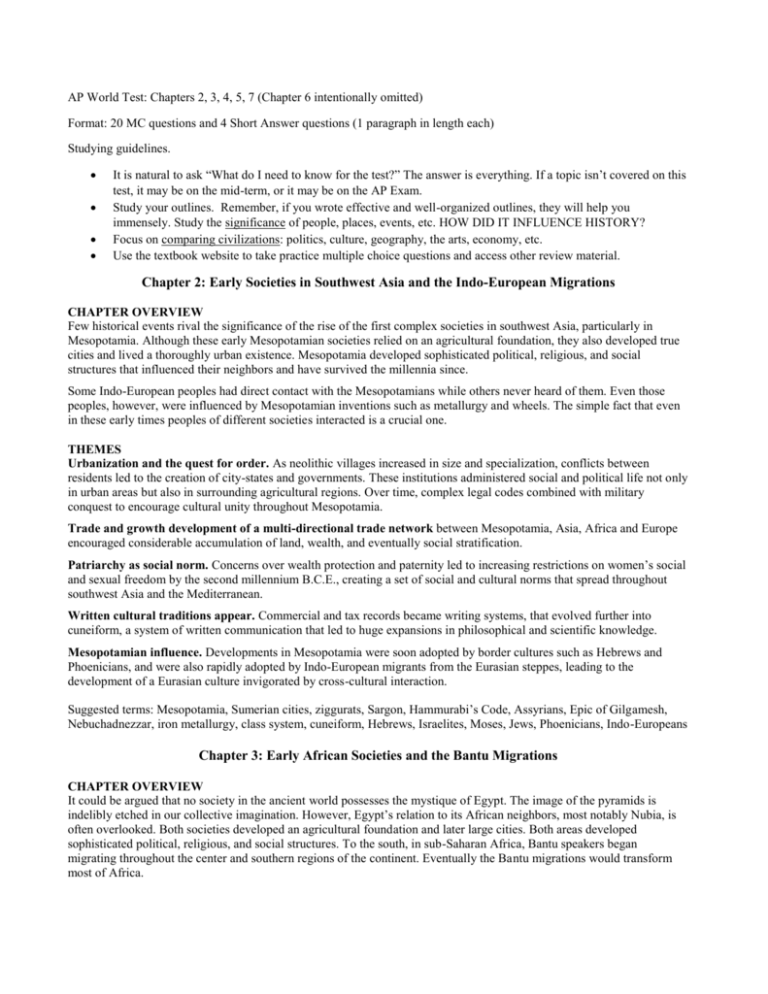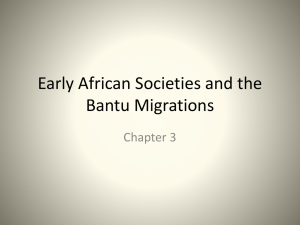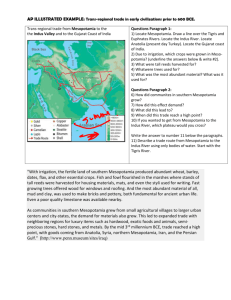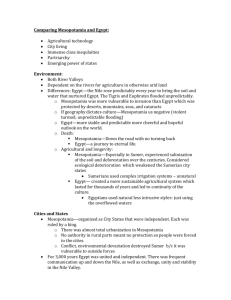File
advertisement

AP World Test: Chapters 2, 3, 4, 5, 7 (Chapter 6 intentionally omitted) Format: 20 MC questions and 4 Short Answer questions (1 paragraph in length each) Studying guidelines. It is natural to ask “What do I need to know for the test?” The answer is everything. If a topic isn’t covered on this test, it may be on the mid-term, or it may be on the AP Exam. Study your outlines. Remember, if you wrote effective and well-organized outlines, they will help you immensely. Study the significance of people, places, events, etc. HOW DID IT INFLUENCE HISTORY? Focus on comparing civilizations: politics, culture, geography, the arts, economy, etc. Use the textbook website to take practice multiple choice questions and access other review material. Chapter 2: Early Societies in Southwest Asia and the Indo-European Migrations CHAPTER OVERVIEW Few historical events rival the significance of the rise of the first complex societies in southwest Asia, particularly in Mesopotamia. Although these early Mesopotamian societies relied on an agricultural foundation, they also developed true cities and lived a thoroughly urban existence. Mesopotamia developed sophisticated political, religious, and social structures that influenced their neighbors and have survived the millennia since. Some Indo-European peoples had direct contact with the Mesopotamians while others never heard of them. Even those peoples, however, were influenced by Mesopotamian inventions such as metallurgy and wheels. The simple fact that even in these early times peoples of different societies interacted is a crucial one. THEMES Urbanization and the quest for order. As neolithic villages increased in size and specialization, conflicts between residents led to the creation of city-states and governments. These institutions administered social and political life not only in urban areas but also in surrounding agricultural regions. Over time, complex legal codes combined with military conquest to encourage cultural unity throughout Mesopotamia. Trade and growth development of a multi-directional trade network between Mesopotamia, Asia, Africa and Europe encouraged considerable accumulation of land, wealth, and eventually social stratification. Patriarchy as social norm. Concerns over wealth protection and paternity led to increasing restrictions on women’s social and sexual freedom by the second millennium B.C.E., creating a set of social and cultural norms that spread throughout southwest Asia and the Mediterranean. Written cultural traditions appear. Commercial and tax records became writing systems, that evolved further into cuneiform, a system of written communication that led to huge expansions in philosophical and scientific knowledge. Mesopotamian influence. Developments in Mesopotamia were soon adopted by border cultures such as Hebrews and Phoenicians, and were also rapidly adopted by Indo-European migrants from the Eurasian steppes, leading to the development of a Eurasian culture invigorated by cross-cultural interaction. Suggested terms: Mesopotamia, Sumerian cities, ziggurats, Sargon, Hammurabi’s Code, Assyrians, Epic of Gilgamesh, Nebuchadnezzar, iron metallurgy, class system, cuneiform, Hebrews, Israelites, Moses, Jews, Phoenicians, Indo-Europeans Chapter 3: Early African Societies and the Bantu Migrations CHAPTER OVERVIEW It could be argued that no society in the ancient world possesses the mystique of Egypt. The image of the pyramids is indelibly etched in our collective imagination. However, Egypt’s relation to its African neighbors, most notably Nubia, is often overlooked. Both societies developed an agricultural foundation and later large cities. Both areas developed sophisticated political, religious, and social structures. To the south, in sub-Saharan Africa, Bantu speakers began migrating throughout the center and southern regions of the continent. Eventually the Bantu migrations would transform most of Africa. THEMES Agriculture and climatic change. Rising temperatures in northern Africa led to changes in human behavior that encouraged agricultural development. Many human communities concentrated along river valleys, such as the Nile valley. Cross-cultural interaction. Egypt and Nubia developed close economic and commercial ties, a process that encouraged a vast exchange of ideas, people, and commodities. The growth of centralized government. Centralized political authority was embodied in the absolute ruler, the pharaoh in Egypt and the person of the king in the region of Kush (Nubia). Elsewhere in Africa, Bantu speakers constructed communities around agricultural traditions that emphasized age groupings rather than social status. Development of organized religion. Organized religious traditions appeared in Egypt and Nubia, including worship of Amon and Re, sun gods, the cult of Osiris, pyramid building, and in Egypt, mummification of the dead. Monotheism predominated among Bantu speakers and other African peoples. Skills and iron. Emergence of complex city-states allowed Nile valley peoples to expand skill-sets and construct extensive trade networks. In both northern and sub-Saharan Africa, iron work provided a catalyst for migration and territorial expansion. Suggested terms: Menes, Egypt v. Nubia, Kush, Hyksos, class system, Hatshepsut, hieroglyphics, Amon and Re, Aten, Cult of Osiris, the Bantu Chapter 4: Early Societies in South Asia CHAPTER OVERVIEW India is a country with an extraordinarily brilliant, in some ways almost unmatched, cultural and religious tradition. At the same time, the Indian political world, marred by fragmentation and invasion, has been chaotic. India is also one of the oldest societies, with the unique Harappan civilization stretching back to at least 2500 B.C.E. The arrival of the IndoEuropean Aryans around 1500 B.C.E. brought profound political, religious, and cultural change. Eventually the combination of native Dravidian and Aryan concepts gave rise to a rich and varied intellectual world. Hinduism, the dominant religion in India, is the best example of this evolving process. THEMES Migration and cultural exchange. South Asia experienced recurring waves of migration, a process that helped create new, unique forms of cultural and social development. The rise of regional kingdoms. Communal and local political organization gave way to regional kingdoms in India, although little is known about early Harappan political systems. Religion as social foundation. Organized religious traditions based on ancestor veneration and mythology were standardized and used as vehicles for the creation of complex social hierarchies in India; an example is the caste system. These religious ideas also deeply embedded themselves in society, serving as cultural norms for millennia. Patriarchy and social order. India employed patriarchy as the preferred form of gender relations, both within family groups and throughout society as a whole. As with religious beliefs, patriarchy continues to significantly influence human relationships. Suggested terms: Harrapa, Mohenjo-Daro, class/caste system, Aryans, Vedas, Rig Veda, varna, jati, Lawbook of Manu, sati, Dravidians, Upanishads, Brahman, karma, Moksha Chapter 5: Early Society in East Asia CHAPTER OVERVIEW Human beings have inhabited east Asia since at least two hundred thousand years ago. The domestication of rice began around 7000 B.C.E., and neolithic societies such as the Yangshao rose in the valley of the Yellow River by approximately 5000 B.C.E. Early dynasties such as the Xia, Shang, and Zhou saw the rise of a distinctive and in many ways uniquely secular society. Politically, none of the early dynasties achieved centralization until the Qin unification in 221 B.C.E. Nevertheless, despite centuries of unstable political decentralization and at times outright warfare, the Chinese moved inexorably toward the establishment of a remarkably sophisticated political and social structure. Works such as the Zhou classics, and especially the Book of Songs, remained the foundations of Chinese thought for centuries. THEMES Geography and the emergence of complex society. Like Mesopotamia and Egypt, complex societies emerged in east Asia along river valleys, such as the Yellow and Yangtze rivers. Alluvial soil created the potential for agricultural surplus, which increased populations and facilitated civilization and urban complexity. Migration and cultural exchange. Despite geographic obstacles, such as deserts, mountains, and large bodies of water, the ancient Chinese did trade and communicate with members of other societies, resulting in the spread of wheat cultivation, bronze and iron metallurgy, horse-drawn chariots, and wheeled vehicles. The distinctiveness of Chinese society. Chinese language, writing, and beliefs were very different than those of other societies. Religion as social foundation. Organized religious traditions based on ancestor veneration and mythology were standardized and used as vehicles for the creation of complex social hierarchies in ancient China. Patriarchy and social order. Both China and India employed patriarchy as the preferred form of gender relations, both within family groups and throughout society as a whole. As with religious beliefs, patriarchy continues to significantly influence human relationships in these regions. Suggested Terms: Yangshao Society, Banpo Village, Xia Dynasty, Shang Dynasty, Lady Fu Hao, Zhou Dynasty, “mandate of heaven”, class system, Period of the Warring States, oracle bone, Book of Changes, Book of History, Book of Etiquette, Book of Songs, Yellow River v. Yanzi Valley Chapter 7: Empires of Persia CHAPTER OVERVIEW Classical Persian society has its origins in the sixth century B.C.E. with the rise of the dynasty of the Achaemenids (558330 B.C.E.) under Cyrus the Great. Later rulers such as Cambyses, Darius, and Xerxes created the largest, most stable, and in many ways most tolerant empire of its age. The Persian political, social, and religious influences transcended the centuries. Eventually the Achaemenids were followed by the Seleucids (323-83 B.C.E.), the Parthians (247 B.C.E.-224 C.E.), and finally the Sasanids (224-651 C.E.).When the Sasanids were defeated by Islamic invaders in 651, a new age in Persian history dawned. THEMES Central Asian origins. Warrior nomads from central Asia moved into Iran and established a vast empire stretching across southwest Asia, an empire that influenced subsequent civilizations in the region for over one thousand years afterward. Complex imperial structures. The empire’s size encouraged a series of innovative responses, including an imperial transportation network, large public works projects, and complex administrative hierarchies, including an educated bureaucratic class. High agricultural productivity allowed and encouraged vocational specialization and the emergence of long-distance trade. Complex stratified society emerges. Increased social complexity exposed greater divisions between rich and poor, and even led to organized slavery. These developments also occurred in China, India, and the Mediterranean basin. Cross-cultural influences. Persia became a conduit for ideas and products that passed between the Mediterranean, Mesopotamia, and India. In time, distinctive Persian religious beliefs emerged, in particular Zoroastrianism, whose monotheism exerted profound influence on the three monotheistic world religions that followed: Judaism, Christianity, and Islam. Suggested Terms: Achaemenids, Seleucids, Parthians, Sassanids, Cyrus, Darius, Persian Wars, Alexander the Great, class system, Zoroastrianism, Zarathustra, Gathas







